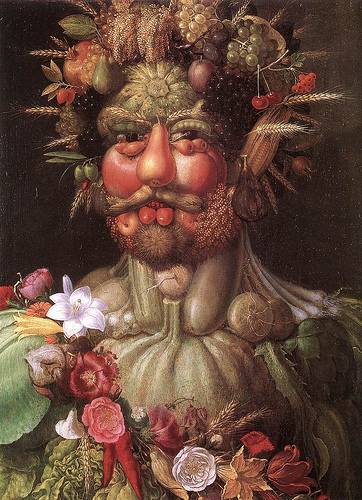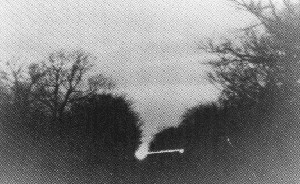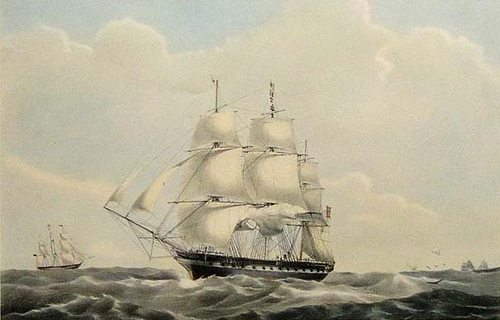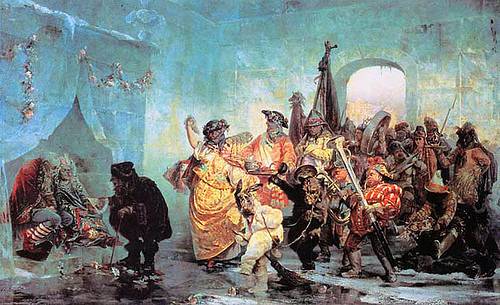
In Vertumnus, Giuseppe Arcimboldo portrayed his patron Rudolf II as the Roman god of growth and change. Fortunately, Rudolf appreciated the metaphor and awarded Arcimboldo one of his highest orders.
See also Renaissance Surrealism and The Librarian.

In Vertumnus, Giuseppe Arcimboldo portrayed his patron Rudolf II as the Roman god of growth and change. Fortunately, Rudolf appreciated the metaphor and awarded Arcimboldo one of his highest orders.
See also Renaissance Surrealism and The Librarian.
“Summer afternoon — summer afternoon; to me those have always been the two most beautiful words in the English language.” — Henry James
A young schizophrenic named Struther,
When told of the death of his brother,
Said: “Yes, it’s too bad,
But I can’t feel too sad —
After all, I still have each other.”
— Anonymous

From the three-state junction of Kansas, Missouri, and Oklahoma, drive four miles south to Oklahoma East 50 Road, park your car, and look west. You’ll be looking into an uninhabited area known as the Devil’s Promenade, and on many nights you’ll see a ball of light floating about 2 feet above the ground.
No one knows what it is. Beyond the forested hills lies Interstate 44, so possibly it’s an effect of headlights, but the first documented sighting occurred in 1881, and the photograph above was taken in the early 1900s.
Lend me $10, but give me only half of it.
Then you’ll owe me $5, and I’ll owe you $5, and we’ll be even.
A visitor’s description of William Kingston, a Somerset farmer born without arms, recounted in John Platts, Encyclopedia of Natural and Artificial Wonders and Curiosities, 1876:
He highly entertained us at breakfast, by putting his half-naked feet upon the table as he sat, and carrying his tea and toast between his great and second toe to his mouth, with as much facility as if his foot had been a hand, and his toes fingers. … He then shewed me how he shaves himself with the razor in his toes; and he can comb his own hair. He can dress and undress himself, except buttoning his clothes. He feeds himself, and can bring both his meat or his broth to his mouth, by holding the fork or spoon in his toes. He cleans his own shoes, lights the fire, and does almost any domestic business as well as any other man. … He can milk his cows with his toes, and cuts his own hay, binds it up in bundles, and carries it about the field for his cattle. Last winter he had eight heifers constantly to fodder. The last summer he made all his hay-ricks. He can do all the business of the hay-field (except mowing) as fast and as well with his feet as others can with rakes and forks. … In a word, he can nearly do as much without as others can with their arms.

The British merchant ship Madagascar set sail from Melbourne in August 1853, headed for London and carrying 60,000 ounces of gold dust.
She was never seen again.
I thought I knew I knew it all,
But now I must confess,
The more I know I know I know,
I know I know the less.
— Anonymous
In the 1890s, William Randoph Hearst’s New York Journal was in a circulation war with Joseph Pulitzer’s New York World. When the World published an obituary of “Reflipe W. Thanuz,” Hearst revealed a trap — there was no such person, so Pulitzer must have stolen the item from his paper. (“Reflipe W” is “we pilfer” spelled backward, and “Thanuz” is “the news”.)
Pulitzer got his revenge, though. He planted the name “Lister A. Raah” in a World story, and when the Journal ran a similar item, he revealed that the name was an anagram of “Hearst a liar.”
See also Nihilartikels.

In 1739, to celebrate Russia’s victory over Turkey, empress Anna Ivanovna ordered a palace of ice to be built in St. Petersburg. Designed by architect Pyotr Yeropkin, the massive building was 60 meters long and 6.5 high, surrounded by sculptures and artillery, fully furnished (including a bed, mattress, and pillows), and featuring a garden filled with trees, birds, and even an elephant. All of this was made entirely of ice.
It melted the following summer.